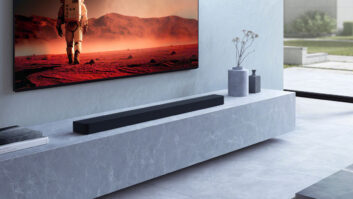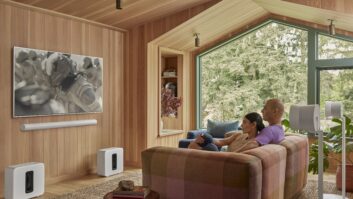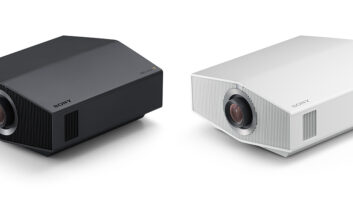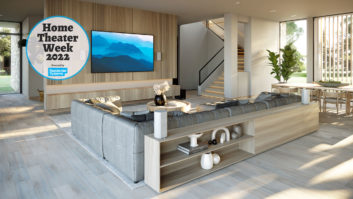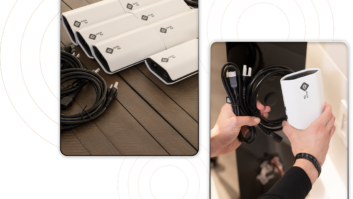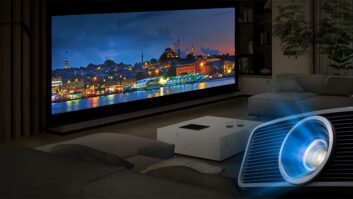While we expect a display technology refresh almost every year, speakers generally have a much longer lifespan. But the rapidly evolving, high-performance soundbar category lies in the middle ground of that upgrade cycle, needing to keep pace as new technologies are developed.
Generally, we’ll see more frequent refreshes in the middle and lower end of the soundbar line as companies chase a price, feature, or performance level, but higher-end bars generally have a little longer life. At CES 2020 we saw new bars at the high-end introduced from Klipsch, JBL, LG, and Samsung, but Sony was content to ride its HT-ST5000 for its top-end offering.
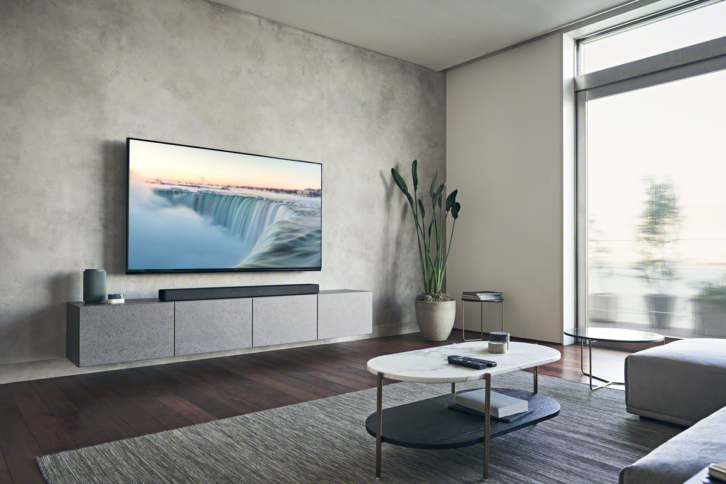
Of course, after four-plus years in the line-up, the ST5000 was getting a little long in the tooth, and was more “flagging” than “flagship.” From my original review it had a list of concerns that included no support for DTS/DTS:X, no ability to add wireless rear speakers, and no room correction. On top of that, it didn’t support eARC, had a limited OSD, and, of course, wasn’t future-ready for the new 8K and 4K/120 HDMI 2.1 outputs on the horizon. (The DTS/DTS:X and eARC features were since updated in firmware.)
Sony was laying the groundwork for replacement bars when some of its new high-end 2021 displays (namely the Z90J, A90J, A80J, and X95J) came with a mysterious jack labeled “S-Center Speaker In.” I happened to be reviewing a new XR65A80J OLED, and when I inquired about this connection, Sony’s PR team gave a really nebulous, “This is for a future feature we can’t really discuss right now…stay tuned!” answer.
Right before CEDIA Expo, Sony let the cat out of the bag that there would be two new speaker systems coming that would support this S-Center connection: one the new flagship HT-A7000 soundbar, and a new premium speaker system called the HT-A9. Sony prepared a full HT-A7000 system for review and shipped it out, giving me quite a bit of time to experience it before its release at the end of October.
Appearance
One of the biggest external changes with this new bar is that it is just that…a new bar. While nearly every other Sony soundbar — including most of the entry models and the ST5000 that the A7000 replaces — includes a wireless subwoofer, Sony has taken an à la carte approach, offering the bar standalone, with two optional subwoofers (the SA-SW3 and SA-SW5) and rear speakers (SA-RS35) available to complete the package. For my review, Sony sent along an SA-SW5 and pair of SA-RS35s for a full surround system.
With the A7000 selling for just under $1300 on its own, this makes the whole package a $2050/$2350 proposition depending on which sub is selected, certainly placing it at the premium end of the soundbar category. Of course, for the CI channel, it is a welcome alternative to have a premium solution to offer that is still a relative “value” when compared with traditional receiver/surround speaker packages, especially when you factor in the installation labor savings.
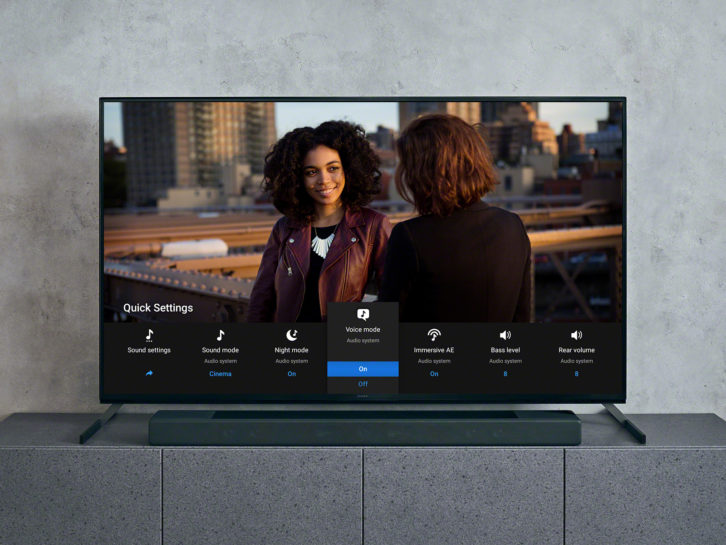
Once unboxed, it’s clear this bar is larger — about 5 inches wider — than the ST5000. It is also much nicer looking, with the top finished in a nice glossy black, the entire front covered by a uniform mesh grille, and the upfiring drivers covered in black cloth instead of the old perf metal. Offsetting the size is the bar’s new smooth, rounded edges that echo the aesthetic designs of Sony’s new panels.
Weighing in at just under 20 pounds, it also has a luxe feel to it — Sony took some thought and care with the fit-and-finish. Also, where I found LG’s excellent-sounding SN11RG bar to feel a bit hollow and plasticky, especially when rapping on the top of it, this feels solid and substantial.
Another small but welcome change was Sony eliminating the ST5000’s removable front grille. Whenever I would move the ST5000 around to access its rear panel connections, this grille would dislodge and often fall on the floor. There’s no need to get at the drivers, so the removable grille really served no purpose.
While the new subwoofers aren’t ugly, they aren’t going to win any visual design awards either, and I think the old sub included with the ST5000 looks nicer. The new subs are finished in a dark charcoal gray with a pebbled finish and rounded corners and edges that match the design of the A7000, with a grille cloth covering the front and back. With no buttons or controls for users to worry over, this is a set-it-and-forget it device that will likely spend its days unobtrusively over in a corner.
The surround speakers also echo the family look, with rounded edges, finished in a dark speckled graphite color. At just 4 x 7.4 x 4 inches (w x h x d), they are small enough to discreetly sit on a shelf, table, cabinet, or stand. Unlike some of the competitor’s — LG and Samsung — rear offerings, these Sonys don’t feature any kind of upfiring, height element driver.
Installation
The big decision with any soundbar installation is whether it will go on the wall or just sit on a tabletop. Sony includes a template to simplify the install, as well as L-brackets, which are becoming increasingly popular for mounting these larger bars.
I opted for a tabletop install, which came with the benefit of letting me move it to different locations to hear how it performed in different rooms sizes and shape. At just 3.25 inches high, the bar is thin enough to sit in front of most tabletop-mounted TVs without impeding the screen, and it includes an IR passthru mode in case it blocks the TV’s receiver. Of course, if you have something like the new Sony A90J series that slams the bottom of the screen right to the deck, you’ll have to figure out another solution.
Connections are straightforward, with two HDMI inputs along with an HDMI output that supports eARC. Notable is that all three of these are HDMI 2.1 and support 8K and 4K/120 resolutions, along with Dolby Vision. If the bar were wall-mounted, the positioning of the HDMI 2 input could pose an issue. Additionally, there is an optical audio input should the display not support the more reliable and robust eARC, as well as an analog audio mini-jack connection should you want to connect a turntable or the like, and a USB connection. Another nod to custom-friendliness is the inclusion of a detachable power cable.
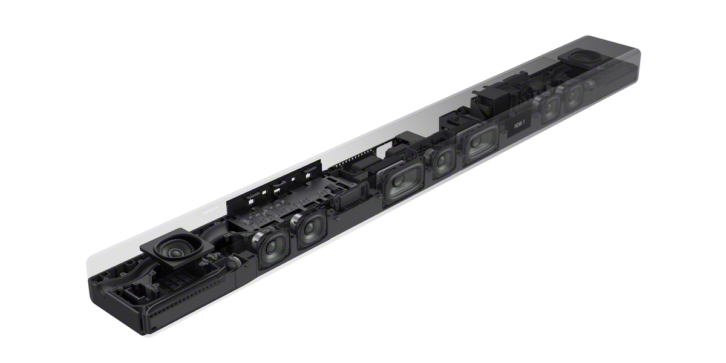
The other new connection of interest to Sony TV owners is the aforementioned S-Center-Out mini-jack. Should your Sony TV have a corresponding input, this is a simple plug-and-plug connection via an included cable that is automatically enabled when connected.
Another benefit for owners of Sony 2021 model TVs is a new integrated onscreen user interface when the TV and bar are connected via eARC. Here you can get quick onscreen access and control over key bar features within the TVs GUI for things like rear and sub volume, changing sound modes, enabling voice or night mode, etc. This isn’t a game changer, per se, but it is a feature I surely missed when I moved the bar from my 2021 A80J OLED to my 2020 X950H LED, and is certainly another strong argument for pairing this Sony bar with a Sony display.
Setup is pretty straightforward and primarily revolves around getting the bar connected to your Wi-Fi, which can be done in a variety of manners, including as an AirPlay2 speaker, via Google Home, or using the OSD. It also walks you through enabling Chromecast and voice control via Amazon Alexa or Google Home.
Connecting the optional rear speakers and subwoofers is literally as simple as plugging them in. (The surrounds are labeled “left” and “right,” so you know which to put where.) Once connected to power, they immediately create a link with the bar, requiring no effort on my part, and the speakers illuminate with a green LED to show they are paired. The rears do have both a keyhole and a threaded insert for wall or stand mounting.
One setup feature worth mentioning is the speaker settings. Here you can either manually enter the information for distance (listener to bar, bar to side walls, bar to ceiling) and level (individual for front, height, beam tweeter L and R, subwoofer, rear speaker L and R in from –6 to +6 dB in .5 dB increments), or you can use the automatic sound optimizer for this. The optimizer plays a series of tones and tweets from all of the drivers and then automatically calculates this information.
My gripe here is threefold. One, you can never see what these values are to check against them. Two, you can’t adjust these values, say, bumping up the levels of the height or beam tweeters. (You can adjust the sub and rear channels directly from the remote or the integrated OSD.) Third, the microphone for measuring these tones is in the bar, not at the seating position, so there is an inherent inaccuracy in the measurement.
So, kudos to Sony for doing something here to automate setup, but it would be great to see some actual room correction being done using a separate microphone at the listening position, and then making these results visible and editable by the end user or installer. It’s not a big ask, but has the potential for yielding significant performance improvements.
While the bar does have a Voice Up feature that increases dialog output, this is just an Off or On setting. (On seems to increase the level by about 2 dB.) I’d have preferred at least a three-step normal-medium-max, or, better yet, a center channel adjustment in the same +/– 6 dB steps as the other channels.
Beyond using Bluetooth to send audio to the bar (blech!), it also supports transmitting Bluetooth signals from the bar to headphones, which is a popular option. Unfortunately, doing so cuts off sound from the bar itself, so it is an either/or proposition.
While there is only the smallest mention in the operating instructions, Sony also offers its Music Center app, which is handy for using a mobile device for switching inputs, sound modes, adjusting levels, and streaming content from a NAS drive.
As is the case with many recent Sony products, the HT-A7000 supports Control4’s SDDP protocol for easy discovery and adding to a project.
Performance
The A7000 features a total of 11 drivers — five front-firing drivers, including a dedicated center channel; two side-firing beam tweeters; two upfiring height drivers; and two built-in subwoofers — each driven by 45.5-watt amplifiers for a total of 500 watts.
Sony says the A7000 utilizes Sony’s new proprietary X-Balanced speaker units to achieve high SPL levels with low distortion, and, with improved signal processing algorithms, the side-firing beam tweeters and dual independent front left and right X-balanced speakers create an expansive soundstage.
As has been Sony’s recent habit, the bar features some capacitive-touch top panel buttons for basic control — power, input, Bluetooth, volume — and pressing and holding two of these buttons can kick off demos of either a 30-second 360 Reality Audio clip or a 1:30 Dolby Atmos demo. These make for great showfloor demos of just what to expect, letting people experience the bar’s surround capabilities without having to cue up anything.
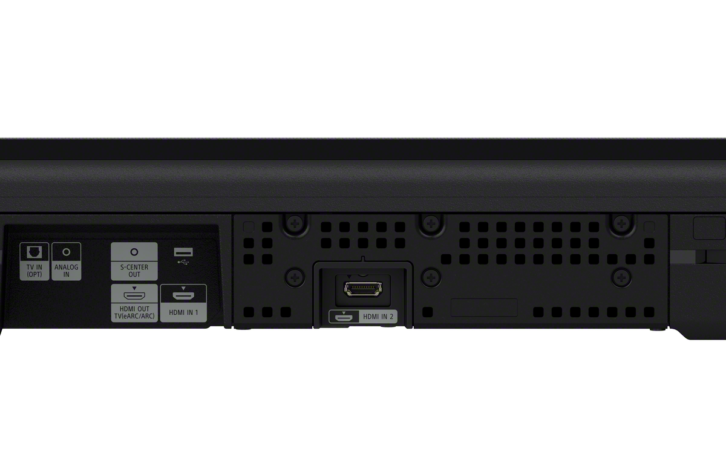
I started off listening to the bar on its own to get an idea of its capabilities. From the first time I ran the sound optimization, the extreme width provided by the beam tweeters along with the expansiveness of the height drivers was clearly apparent. With these tones playing, you get a sense of the spaciousness the bar can deliver in your space, with the tones from the beam drivers producing audio signals well out to the side of the bar, delivering very convincing side-channel audio. In fact, I think one of the bar’s biggest sonic improvements comes from the addition of these new beam tweeters, which really increase the width of the presentation. Sounds happening off screen happen way off screen, delivering a convincing side-surround channel experience. They also create a far more cohesive, front-to-back, full surround experience when the rear speakers are added.
While the bar might technically have built-in subwoofers, don’t expect it to deliver the kind of powerful low-end you’d get from adding an actual subwoofer, or the bass output from a bar with multiple large drivers like Sennheiser’s Ambeo (which remains the single-bar gold standard). These built-in subs deliver a full sound that will likely satisfy a casual viewer, actually more so on movies than music, where I was more aware of the lack of depth, and obviously room size plays into this. But achieving a more cinematic experience definitely requires adding one of the two subs, which just enlarges the entire presence of the system.
And when it comes to subs, my philosophy is almost always “the bigger, the better,” which is why I requested a sample of the SA-SW5. This features a 7.09-inch active driver with passive radiator powered by a 300-watt amplifier that energizes the air in a room enough to produce tactile bass frequencies you can actually feel. It also has the added benefit of re-equalizing the signals the bar reproduces, engaging low-pass filters in the bar and freeing it from trying to produce the deepest bass.
Without question, adding the subwoofer increased the performance and excitement of everything I watched, whether it was the heavy, low-electronic bass featured in Billie Elish’s Happier Than Ever on Disney+, or the aggressive and kinetic driving bass lines in Hans Zimmers’ Live in Prague concert, or the deep and throaty engine roars and growls from Ford v Ferrari. The sub playing was like a force-multiplier for system performance, making it sound far larger than just a soundbar.
I did have one minor issue with the sub with a specific movie in a couple of instances. When watching X-Men: The Last Stand on Disney+, there were a few instances (one is at 45 minutes where Professor X and Magneto go to meet Jean Grey at her home) where the sub produced a sharp and loud POP! that not only startled me, but worried me about damaging the unit. Granted, we were watching at a pretty loud level (80 out of 100 on the bar), but the subwoofer was set to 7 (out of 12) and the three instances that caused it didn’t seem especially bass heavy.
Regarding the S-Center connection, when connected to a compatible Sony TV, the bar and TV’s speaker work together to create a much larger center channel image. The bar handles low frequencies, off-loading mid- and upper-frequencies to the TV speaker, and with these more localizable sounds coming directly from the screen (in the case of my OLED), it delivers a more immersive audio experience with a more cinematic experience of sounds better matching their on-screen locations.
The S-Center connection definitely raises the audio experience — literally with the added dimension of the TV’s height — and delivers a more immersive experience with height to the presentation, making the experience seem much bigger than with the bar alone, and it adds another compelling reason to have that all-Sony experience.
The A7000 definitely nails that all-important height element, as well, placing sounds clearly up on the ceiling. The 4K re-release of Cliffhanger has a terrific Dolby Atmos mix, and the bar delivered all the excitement of helicopters flying and avalanches crashing down from overhead. Live Die Repeat features another dynamic soundtrack, and during the training scenes, the A7000 filled the room with sounds of blades winging past overhead and all around, along with the open ambience of the training room.
Even non-Atmos encoded content like Tenet benefitted from this expansion, such as the sounds of gas hissing down from above in the Freeport theft scene, or the clear sounds of sails flapping, wood splintering, and stomping footsteps from Master and Commander.
As mentioned, the surround speakers don’t have any height drivers, and that would be the one area where the A7000 system could be elevated even further; adding that additional height element to tie the front and rear together and provide an even more immersive experience.
When most people think “soundbar” they think movies and not music, but the A7000 offers some compelling music listening as well. With Chromecast and Spotify Connect, you can easily beam music to it, and as an AirPlay2 speaker, it can become part of a whole-house music system.
Even though I did get a demo at Sony’s booth during CES 2019, 360 Reality Audio was something new to me. According to Sony, “360 Reality Audio is an audio format that uses Sony’s object-based spatial audio technology to deliver a full 360-degree audio experience.” The good thing is that the bar includes a coupon for a free three-month trial to the supporting streaming service of your choice, including Amazon Music HD, Deezer HiFi, Nugs.net, and Tidal.
I found that music encoded with this 360 generally sounded freer and more open, less constrained to the bar itself, and more expanded. For example, Eddie Vedder’s vocals in “Alive” seemed tied to the bar, whereas the 360-mix lifted him up, freeing him from the confines of the bar. It also sounded smoother, and less hard-edged than the non-360 mix.
As a surround format, these audio mixes also benefitted from the addition of the rear speaker, giving you a far more encompassing sound. Songs like Miles Davis’ “Pharaoh’s Dance” had a swirling, 360 pans that encircled the room, and Duran Duran’s “Invisible” was also a really dynamic, room-filling mix.
Bottom line: The HT-A7000 is a marked improvement at the top of Sony’s soundbar offering, and it creates the foundation of a really impressive system; however, to fully strut its stuff, adding the sub and surrounds delivers marked performance improvement. With the full system installed — bar, sub, and surrounds — it was easy to feel you were listening to a much larger system, forgetting you were listening to a soundbar system, and just sitting back and getting lost in the content.
877-865-7669; SONY.COM
Kudos: Luxury look/feel; integrated OSD; S-Center audio feature; immersive audio experience
Concerns: The entire package pricey compared to other high-end solutions; rear speakers lack height element
Product Specs:
- 1.2-channel soundbar with built-in subwoofer
- 11 built-in speakers including five front firing, two beam tweeters, two up-firing, and two subwoofers; powered by 500-watt digital amplification
- Decodes all major surround formats including Dolby Atmos and DTS:X as well as Hi-res audio up to 96/24 and 360 Reality Audio
- Google Chromecast built-in; also supports Spotify Connect, Apple AirPlay2, and Bluetooth9
- Ready for next-gen HDMI formats including 8K and 4K/120
- 11 a/b/g/n/ac Wi-Fi
- Supports voice control via Amazon Alexa and Google Assistant as well as Control4 SDDP
- Inputs: Two HDMI 2.1/HDCP 2.2 inputs (both 8K and 4K/120 capable), USB, Toslink optical digital, mini-jack analog audio/S-Center Audio In, Ethernet, mini-jack IR, mini-jack RS-232; Outputs: HDMI 2.1/HDCP 2.2 (8K and 4K/120) with eARC, mini-jack S-Center Out; detachable power cord
Dimensions:
- HT-A7000 Bar:
- 51.25 x 3.25 x 5.625 inches (WxHxD)
- Weight: 19.125 pounds
- SA-SW5 Sub:
- 10.9 x 16.1 x 16.61 inches (WxHxD)
- Weight: 28.66 pounds
